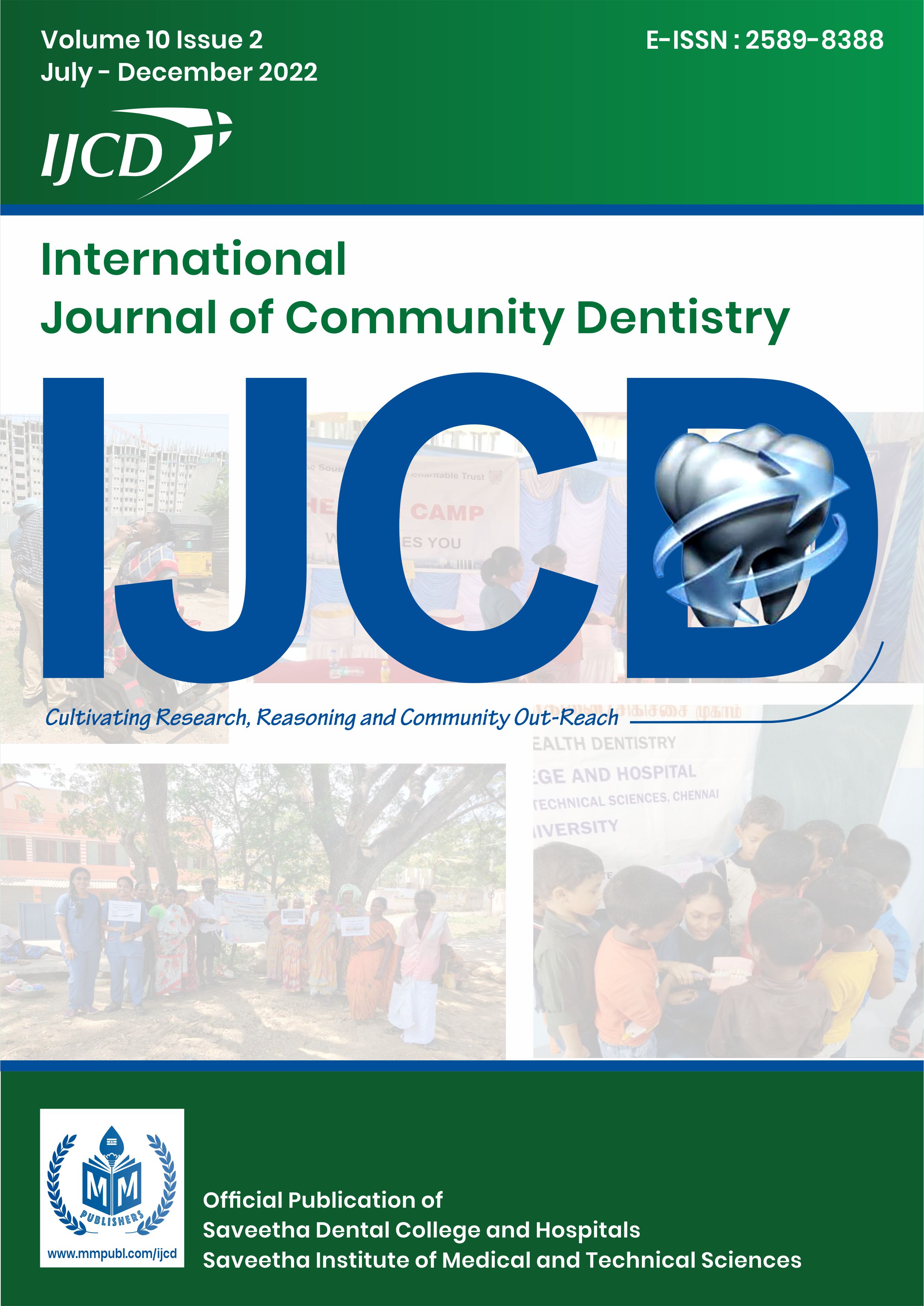Comparative evaluation of oil pulling and chlorhexidine mouthwash in halitosis: A randomized controlled trial
Original Article
DOI:
https://doi.org/10.56501/intjcommunitydent.v10i2.662Keywords:
Halitosis, oil pulling, chlorhexidine, mouthwashesAbstract
Background : Halitosis is an unpleasant malodour from the oral cavity that might be due to systemic origin or oral issues origin. Oil pulling in addition to offering several oral health benefits has also beneficial effects on overall health. The present study aims to evaluate the efficacy of oil pulling when compared to the chlorhexidine mouthwash usage.
Methodology : It was a parallel design, single centre, double blinded randomized controlled trial of 15 days duration. The control group received Chlorhexidine mouthwash (Hexidine mouthwash) and study groups were provided with sesame oil. Halitosis was assessed by arbitrary 0-5 scale for organoleptic odor assessments. Gingivitis was evaluated using Löe and Silness index and plaque with Silness and Löe index.
Results : The mean organoleptic scores at baseline, 15 days post intervention were 4.01 and 1.30 for chlorhexidine. The mean organoleptic scores at baseline, 15 days post intervention were 2.32 and 1.11 for sesame oil pulling group.
Conclusion : It can be concluded that oil pulling is useful in reducing halitosis, plaque and gingivitis.
References
Porter SR, Scully C. Oral malodour (halitosis). BMJ. 2006;23;333(7569):632–635.
van den Broek AM, Feenstra L, de Baat C. A review of the current literature on management of halitosis. Oral Dis. 2008;14(1):30–39.
Yaegaki K, Coil JM, Kamemizu T, Miyazaki H. Tongue brushing and mouth rinsing as basic treatment measures for halitosis. Int Dent J. 2002;52(Suppl 3):192–196.
Patil S, Acharya S, Hathiwala S, Singhal DK, Srinivasan SR, Khatri S. Evaluation of the Efficacy of G32 (Commercially Available Ayurvedic Preparation) in Reducing Halitosis - A Randomized Controlled Trial. J Clin Diagn Res. 2017;11:ZC79–ZC83.
Charles CH, Mostler KM, Bartels LL, Mankodi SM. Comparative antiplaque and antigingivitis effectiveness of a chlorhexidine and an essential oil mouthrinse: 6-month clinical trial. J Clin Periodontol. 2004;31:878–84.
P. Kalyani, L. Leelavathi. Comparison between the effect of plain water, herbal mouthwash, and chlorhexidine mouthwash on salivary pH. Drug Invention Today, 2019, 11(5): 1184-1187
Peedikayil FC, Sreenivasan P, Narayanan A. Effect of coconut oil in plaque related gingivitis—A preliminary report. Nigerian medical journal: journal of the Nigeria Medical Association. 2015 Mar;56(2):143.
Sooryavanshi S, Mardikar BR. Prevention and treatment of diseases of mouth by gandoosha and kavala. Ancient Science of Life. 1994 Jan;13(3-4):266.
Sharma K, Acharya S, Verma E, Singhal D, Singla N. Efficacy of chlorhexidine, hydrogen peroxide and tulsi extract mouthwash in reducing halitosis using spectrophotometric analysis: A randomized controlled trial. Journal of Clinical and Experimental Dentistry. 2019 May;11(5):e457.
Rosenberg M, McCulloh CA. Measurement of oral malodor: Current methods and future prospects. J Periodontol 1992;63:776-82.
Brecx M, Macdonald LL, Legary K, Cheang M, Forgay MG. Long term effects of Meridol and chlorhexidine mouth rinses on plaque, gingivitis, staining and bacterial validity. J Dent Res. 1993;72:1194–7.
Peedikayil FC, Sreenivasan P, Narayanan A. Effect of coconut oil in plaque related gingivitis—A preliminary report. Nigerian medical journal: journal of the Nigeria Medical Association. 2015 Mar;56(2):143.
Asokan S, Kumar RS, Emmadi P, Raghuraman R, Sivakumar N. Effect of oil pulling on halitosis and microorganisms causing halitosis: A randomized controlled pilot trial. Journal of Indian Society of Pedodontics and Preventive Dentistry. 2011 Apr 1;29(2):90.

Downloads
Published
How to Cite
Issue
Section
License
Copyright (c) 2022 Dinesh Karthik V, Rahmath Meeral P

This work is licensed under a Creative Commons Attribution-NonCommercial 4.0 International License.



